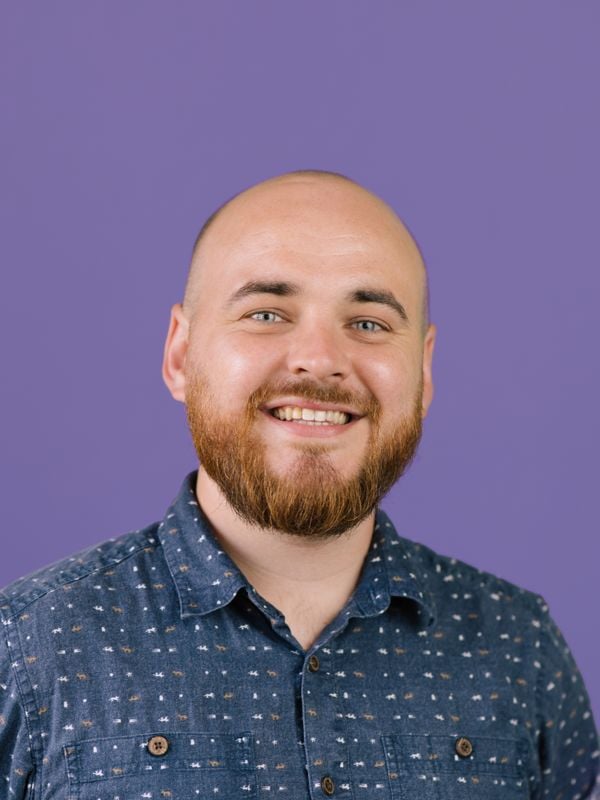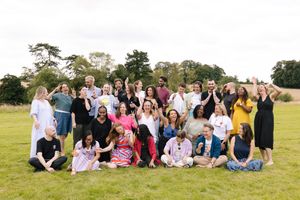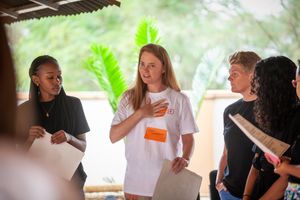What can subterranean subcultures teach us about collective intelligence and action?
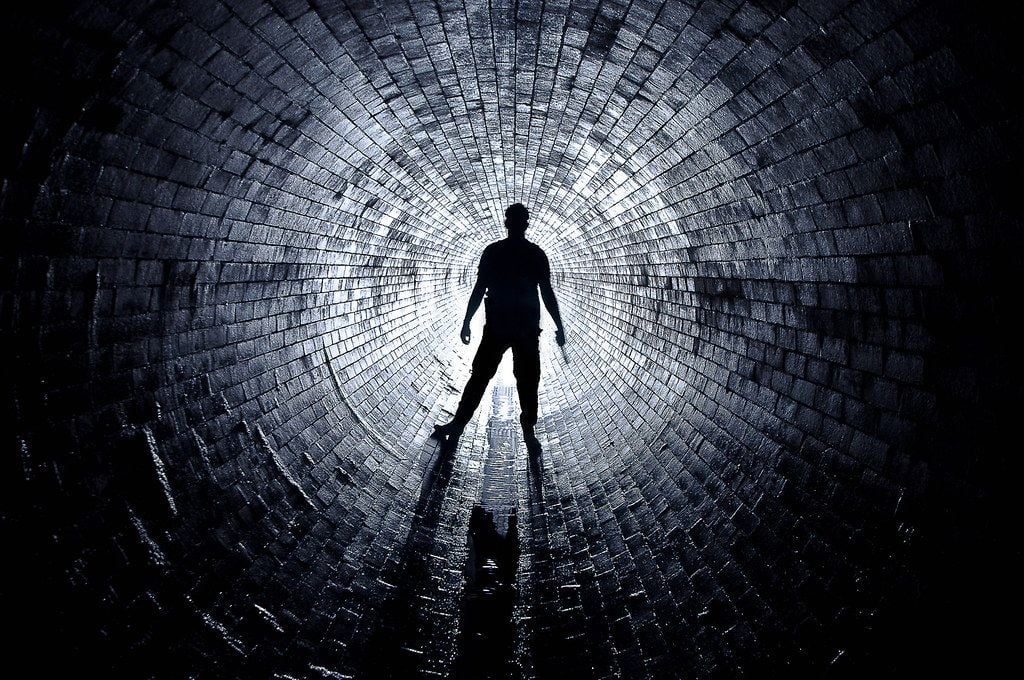
Insights from our third instalment of Collective Conversations, where we explored the worlds of Urban Exploration and Bunker Building.
Deep below the streets of London, there are secret rivers. Wandering those subterranean waterways, which crisscross far beneath a largely oblivious city above, are an unusual rule-breaking collective who revel in the exploration of places and intelligence that they should not know about. Elsewhere, hidden in countries across the globe, collectives of doomsday preppers are also working together on subterranean pursuits; bunker building, disaster planning, and an unusual version of community building for hypothesised end-times.
From helping to inform the future of education to creating digital tools for more sustainable cities, at Brink we are exploring how collectives learn and act together in the world in order to prepare for the challenges of the future. As a behavioural innovation practice, we jump into this conversation about Urban Explorers and Bunker Builders imagining all manner of connections between our respective endeavours, and excited about what unforeseen lessons we might learn from these fringe communities.
Our tour guide into these sub-cultural and subterranean collectives was Dr Bradley Garrett, who joined us from his home in rural southern California. Brad is the kind of academic who researches up-close with his subjects, becoming embedded within their worlds in order to learn with and about them as authentically and fully as possible. Brad has appeared on hit podcasts, released photography books, and been interviewed for GQ, as well as doing all of the journal writing and lecturing that you might expect of an academic working remotely for University College Dublin.
I’ve followed Brad’s work for years. In 2013, Brad’s first book “Explore Everything”, shifted the methods that I was using at the time in pursuit of my PhD; Brad was building intelligence about his topic in the real world, he was learning about his subjects by convening and exploring with them, and he was writing about all of these things in ways that were both intellectually rigorous and creatively compelling. Today at Brink, I continue to learn with people, rather than only for or about them, and I’m still exploring different ways of engaging audiences with rigorous ideas.
Urban Exploration crews, and a question of ‘why?’:
Brad’s PhD was about Urban Explorers; a movement of individuals, self-organised into exploration crews, who are passionate about exploring sites in cities that are abandoned, neglected, secret, or otherwise ‘off-grid’. If you’re imagining dark-clothed people running through a city at nighttime, lifting the lid on sewer inspection chambers and climbing inside, scaling the scaffolding of an unfinished skyscraper, or otherwise slipping into places they definitely shouldn’t be, then you’re on the right track.

For a few eye-widening minutes, Brad played a section from a documentary he helped to make with the exploration crew he was part of, transporting us into the high-energy and high-stakes endeavour of sneaking into a disused part of the London Underground network. Brad went on to describe the collective sense of purpose that binds and drives Urban Exploration crews:
“That's what urban explorers were doing; They were going to these places and writing blogs, outlining the history of local places that were being ignored by the government, oftentimes, because the history was something that maybe people didn't want to remember.”
People become Urban Explorers for a variety of reasons. For some, it’s about the heightened emotional experience of trespass. Others are driven by an aesthetic sensibility towards the neglected and ruined, and a desire to capture rare photographs. Others still have more political objectives, namely to articulate through their practice a protest against the growing surveillance and privatisation of cities. And finally, there are those with more historical motivations, committed to discovering and documenting places they deem to be at-risk of a kind of collective neglect or forgetting.
There are interesting parallels between some of these sentiments and that of other types of collective working together for a common cause: Extinction Rebellion protesters, not scared to confront authority, to spotlight things which should not be ignored; youth-led movements that push against the grain of received wisdom to realise better futures for marginalised and at-risk communities; and, from history, mass gatherings of ramblers 'trespassing’’ together in order confront the denial of public access to open countryside.
Breaking some rules, and following others:
Community guidelines and principles are often used to help structure collective ways of being and doing. From the 10 principles of Burning Man to the informally articulated expectations of participants in the Parkruns that happen across the country every week, Urban Explorers are similarly bound by a series of generally accepted principles that help to govern their shared practice and hold individuals together.
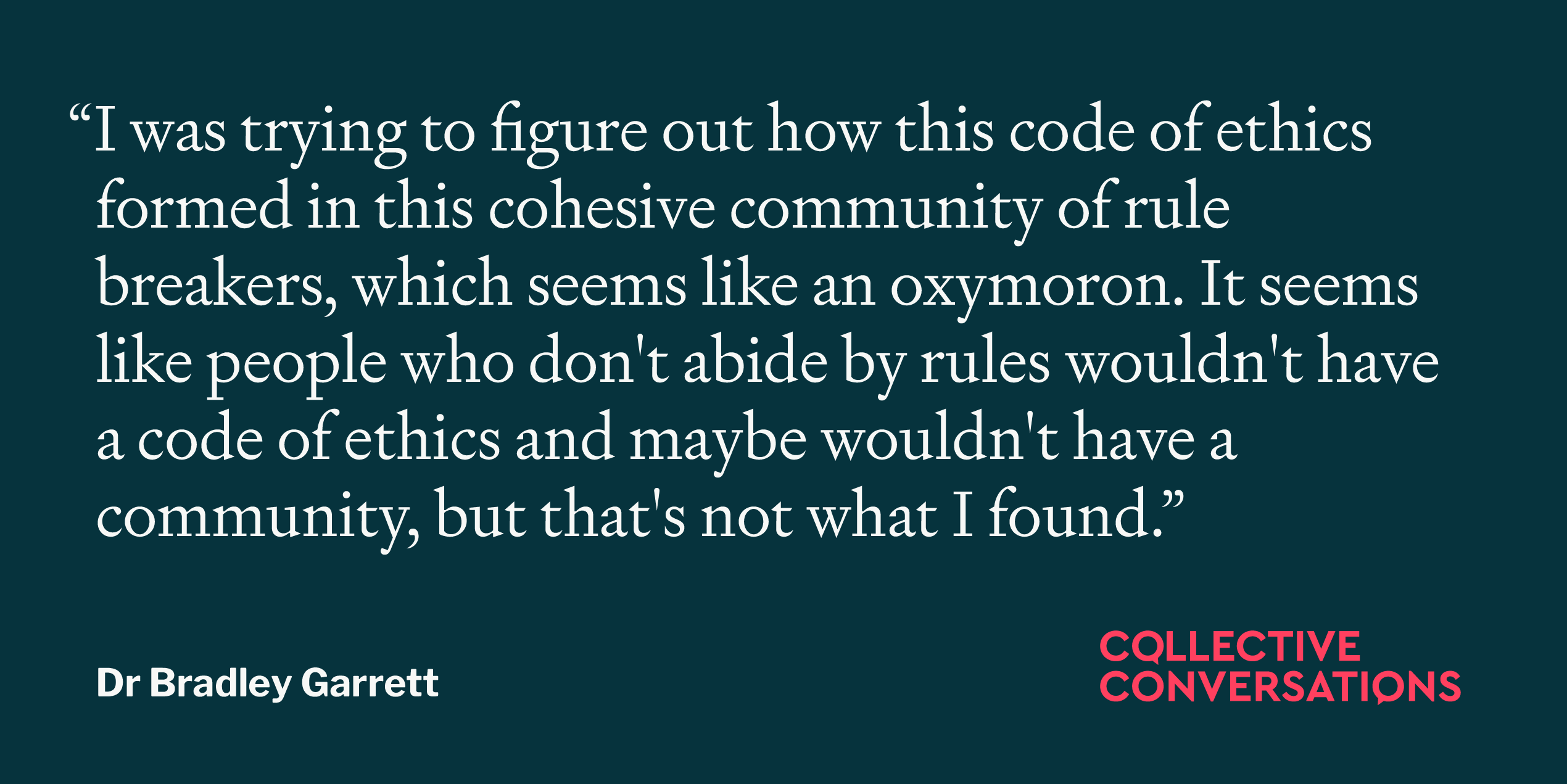
Brad outlined that the constellation of principles which together form this code of ethics includes clear rules of engagement, for instance, not trespassing into people’s homes. As an archaeologist by training (Brad lit up when telling us about the 318 million hand-laid bricks that form the walls of London’s 19th Century sewer system), there’s a sense of “Leave no Trace” in Brad’s approach too; planning carefully ahead of time, leaving what you find behind, and so on.
These are not universal principles shared by all exploration crews (there’s plenty of graffiti tagging and trash to be seen in some of the places that Brad has explored), but a sensibility towards preservation isn’t uncommon with other urban explorers. It’s not quite a reverence for these sites which sees these codes emerge within otherwise rule-breaking communities, but a kind of shared respect for public infrastructure, the hands that built it, the taxes that paid for it, and the function that it once or still does perform for the people above ground.
Are these even communities at all?:
Then Brad transported us thousands of miles away, in the shadows of the Black Hills of South Dakota, where collectives of doomsday preppers have also been building community and finding new purpose within the walls of retired government infrastructure.
Vivos xPoint, originally built by the US Army as a fortress to store bombs and munitions, has been transformed into the largest survival shelter community on Earth. Across Zoom, Brad took us inside these fortresses, showing us photographs of spaces that, by design, very few people will ever see in real life. Whilst the 575 hardened concrete military bunkers will ultimately provide refuge for more than 5,000 survivalists to ride out an unknown future disaster, Brad was there on the community’s first day, when the original families moved in.
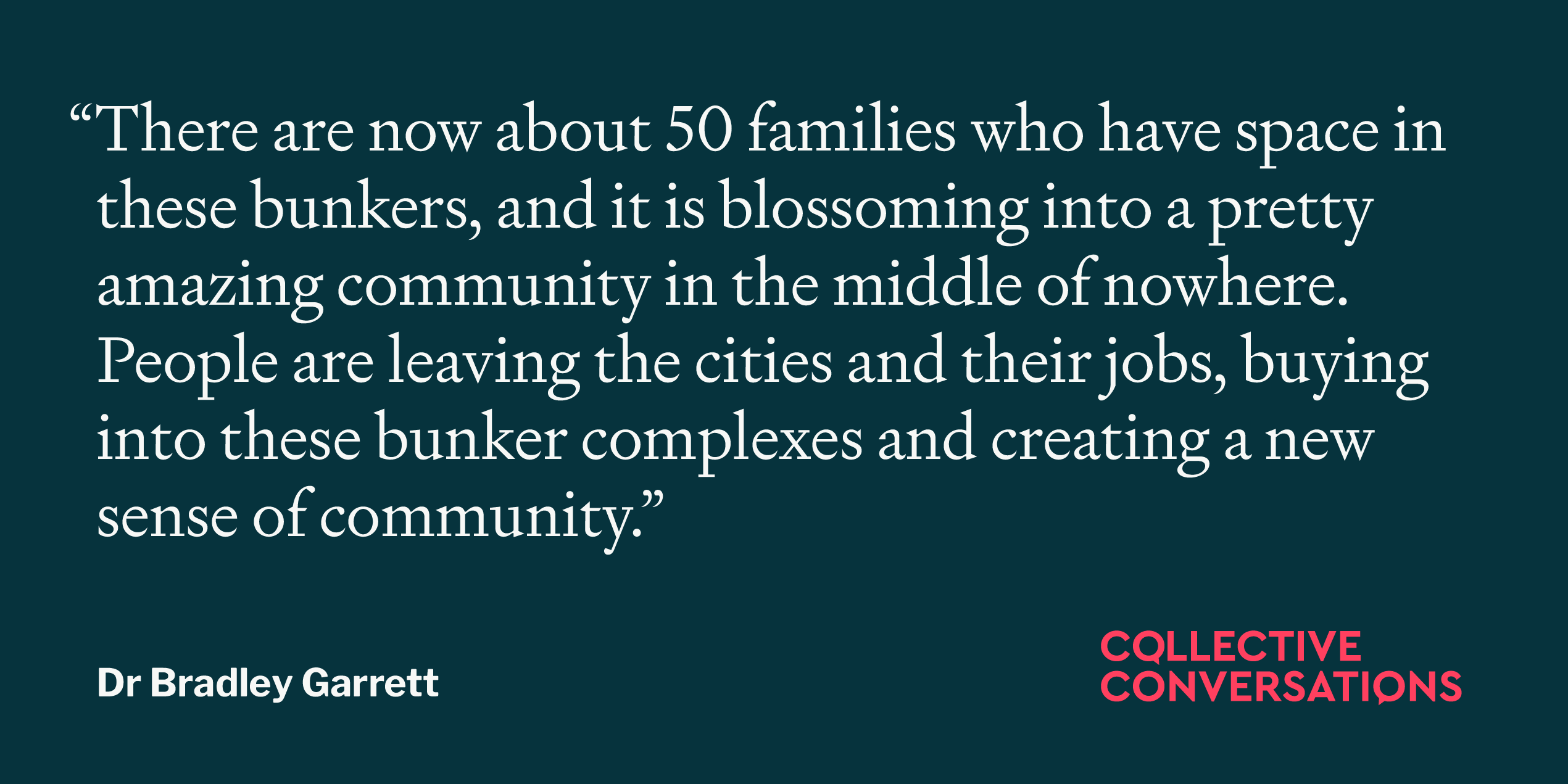
Brad shared with us that the families that move into these bunkers, and other facilities like them the world over, are not as ‘cut from the same cloth’ as we might assume. These individuals and groups have arrived at a similar geographical place, but the intellectual and ideological routes into these bunker communities are varied.
The photos of bunkers kept coming, and we listened as Brad described how survivalists are a diverse community, with real differences in terms of what they are prepping for, and how they are prepping. There are architectural and strategic decisions to be made for starters, with shelters for hypothesised nuclear fallout quite different to those for extreme social unrest. In the chat, Björn asked whether there is a “structure of governance established by the community?”, to which Brad reflected:
“I’m interested in whether these can be considered communities at all. These are people coming together with very different ideologies, political beliefs, and methodologies, and so what holds them together in place doesn’t seem all that normal. Depending on who moves into the community, what their beliefs are, and what they’re prepping for, you end up with totally different communities in different places.”
Brad described that for bunker builders, diversity is an asset to the overall resilience of the community, where pooling skills and knowledge on topics ranging from communications to water infrastructure, are vital. In the chat, Matthew, thinking back to the Urban Explorers, reflected that “a lot of the expertise for these groups seems to come from lived experience, rather than from 'expertise' in the traditional sense.”
From building shared knowledge about your city to very practical tips and tricks for shelter building, the sharing of personal skills and wisdom, and the processes of learning collectively, are indeed crucial for both Urban Explorers and Bunker Builders. For Urban Exploration collectives, Brad described that:
“There was a collective intelligence we were building about things in the city that we weren’t supposed to know, and we were able to put that knowledge into practice in a very practical way...I learnt to pop manholes with a key bought online for £5, to walk underneath the city, and sometimes move through the city more quickly that way!”
Diverse communities of Bunker Builders and Urban Exploration crews demonstrate how communities learning together and sharing knowledge, whilst pushing against the status quo, can grow to become practical collective intelligence over time. For our Collective Conversations audience of social change-makers, innovation managers, systems thinkers, and more, there are lessons here about the mechanics of collaboration and shared learning journeys, in particular perhaps in challenging contexts.
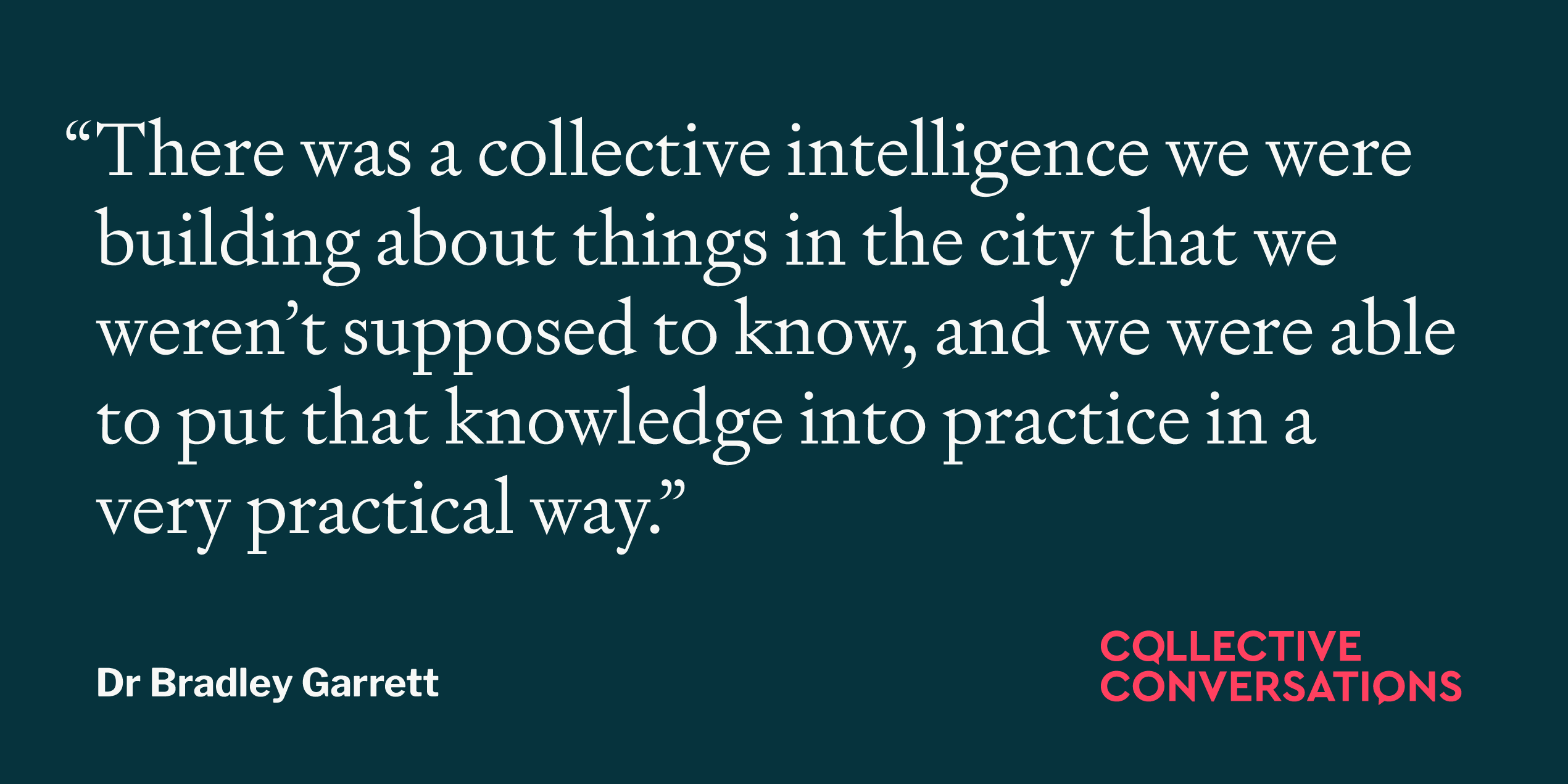
Shared missions help us to learn and act collectively:
Ultimately, Brad concluded that what holds these collectives together is alignment on, and unwavering commitment to, shared missions. Those missions might be more short-term, like exploring abandoned government sites, or more long-term, like the mission to build a community that can be resilient in the face of disaster. Alongside this commitment to pursuing shared purpose though, there’s an unquestionable shared devotion to action, too.
These aren’t collectives that only talk about the doing of a thing, they actually do it. They really do discover and break into lost underground stations. They actually dig holes in the earth and build fallout shelters within them. In the chat, Kelley was intrigued and impressed by this shared commitment to turning goals into actions and reflected that so often inertia derails progress, especially when the doing is hard. But not in these cases.
Brad’s attraction to these particular collectives and what motivates them is not all that surprising. Like them, Brad too is committed to getting stuck in. He didn’t learn about crews of Urban Explorers from an office on a campus somewhere, and he didn’t write about survivalist communities from afar either. Like Brad, we at Brink also learn-by-doing, and also work close to communities to make real change - what we call positive dents - happen. There is more to explore about the connections between our respective practices than we had time for in this instalment of Collective Conversations, and as we closed, the chat was still alive with questions and provocations.
The connections to our work, and the questions we’re left pondering:
The two subcultural and fringe collectives that Brad has become part of, and invited us into, clearly have more in common than a predilection for gathering underground. In the Collectives practice at Brink, we’re driven to understand how communities are built and managed, how they learn together, and how they collaborate for tangible change.
For us, that looks like harnessing collective wisdom across a network of frontier technology pioneers innovating globally to solve the most pressing challenges of today; convening health and data experts to share evidence and best-practice around vaccine hesitancy to improve vaccine uptake where it's most urgently needed; and, supporting humanitarian innovators to collaborate in order to meet the needs of conflict-affected communities.
In these cases and more, we have things in common and things to learn from Urban Explorers and Bunker Builders, and we’d be interested to hear your reflections on some of these questions as we ponder them too:
- How can we galvanise a collective sense of mission and shared principles across a community, particularly when that community is highly diverse?
- How do we build collective intelligence that coheres individual wisdom with shared needs, and where might this intelligence live?
- Where measurable, tangible, and real change is needed, how do we ensure we’re turning our ideas and ambitions into action and results?
- And as we hustle to find solutions or routes to change in the most challenging contexts, what role might rule-breaking play as part of our strategies?
And if you read this as a newbie to Collective Conversations, you can read more and sign-up to get updates and invites to future conversations. To chat more about this blogpost, then you can connect with me on twitter or drop me a line at [email protected]

